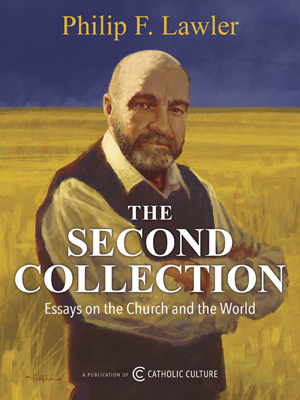Stem Cell Research: A Lesson for Our Time
By Dr. Jeff Mirus ( bio - articles - email ) | Aug 22, 2006
The most hotly debated bioethical issue for the past five years has been the acquisition of stem cells. These cells can transform into a wide variety of human cell types, and so can be used to cure disease. For this reason, a large sector of the medical research community has insisted on the need to harvest stem cells from human embryos. Others have insisted that growing embryos for this purpose is both immoral and inhuman.
Embryonic and Adult Stem Cells
Some aspects of this debate are unlikely to be settled by rational argument. The passion of the medical research community for embryonic experimentation is not always in proportion to the real need for stem cells. Early on, scientists discovered that they can gather stem cells from adult bone marrow and umbilical cord blood, and they have already used such cells to develop cures for more than fifty diseases. By contrast, embryonic stem cell research has not produced a single cure. Yet the demand for embryonic stem cells continues to increase. One may reasonably speculate that this demand is fueled in part by an unrestrained passion for the domination of nature.
Nonetheless, there remains a legitimate interest in tapping the full power of embryonic stem cells, which have a greater ability to differentiate than adult stem cells. Unlike other body cells, stem cells in general have a capability of self-renewal through division. Some stem cells are “unipotent”, which means they can divide and develop into just one type of specialized cell. Adult stem cells are generally “multipotent”, which means they can divide and differentiate into any of a number of closely related cell types. Embryonic stem cells are “pluripotent”, which means they can divide and differentiate into a far wider range of cell types. Even more powerful are “totipotent” stem cells, the kind that are produced from the initial union of a sperm and an egg. A single totipotent cell is the material component of the newly conceived human person, capable of producing every kind of cell necessary to human development.
Technology and Morality
Because of the promise of pluripotent cells, especially when genetically similar to the cells of a particular medical patient, there is inevitable interest in harvesting them when they first appear in embryonic development (at the blastocyst stage). But the moral problem is obvious. Harvesting such cells not only uses parts of a person’s body without his consent, but kills the person in the process. This moral scenario becomes even grimmer when embryos are actually grown and killed for this purpose. Even if the cells could be removed without harming the embryo, or removed only from already dead embryos, the procedure would raise grave moral questions, in effect placing an unwholesome premium on body parts from which the unscrupulous might be all too quick to profit. As things are, however, we do not have the luxury of debating these lesser concerns. To put it bluntly, harvesting embryonic stem cells kills babies.
Yet it may now be possible to convert adult cells into pluripotent stem cells in a way which meets the most stringent moral tests. The most well-known method proposed for doing this is Altered Nuclear Transfer - Oocyte Assisted Reprogramming (ANT-OAR). The theory behind this initiative has been carefully articulated to put the latest scientific research at the service of the best theological and philosophical understanding. All three disciplines are necessary. From theology, we learn the special reverence due to the human person, a reverence which is derived from Revelation and characteristic only of Judeo-Christian societies. From philosophy, we learn when a collection of cells has the potential to be a human person and when it does not. And from science, we learn technologies to solve material problems.
ANT-OAR in a Nutshell
The ANT-OAR initiative has been proposed by its backers precisely as a means to produce pluripotent stem cells without using an embryo, and therefore without the slightest risk to the dignity or life of a human person. The technology of ANT-OAR relies on the two scientific developments hyphenated in its rather long name. The first is Altered Nuclear Transfer (ANT), by which it is possible to fuse an oocyte (egg cell) with an altered adult cell to produce a hybrid capable of generating stem cells. An adult cell is removed from a patient and its DNA is altered to control the types of cellular “expressions” its nucleus is capable of supporting. Then DNA is removed from an oocyte and replaced by fusing the oocyte with the altered adult cell. This new ANT cell can then produce stem cells genetically identical to the patient from whom the original adult cell was taken.
By itself, ANT is not sufficient, because the new ANT cell passes through various stages before producing the new pluripotent stem cells, and it is at least possible (perhaps probable) that the ANT cell becomes a human embryo, however briefly, during these changes. Various mechanisms can be used to ensure that this does not, in fact, occur, but the most promising mechanism is OAR. OAR depends on the ability of the cytoplasm of the oocyte to assist with the process by which cells are “programmed” to become one type of cell or another.
All cells carry the same genetic information. It is how this information is used (or not used) that determines what function each cell will perform (what type of cell it will be). Genes are, in effect, turned on and off to control development in a process called epigenetic programming. It is possible to turn on the genes necessary to transform an adult cell into a pluripotent stem cell, but these genetic changes are not by themselves sufficient to overcome the prior programming of the differentiated adult cell. The oocyte’s cytoplasm, however, has the ability to strip away this prior programming. Thus oocyte assisted reprogramming (OAR) can be used to change an adult cell into a pluripotent stem cell in a single step, with no intervening development.
Key Philosophical Point
The key philosophical point here—and the factor which makes ANT-OAR so ethically promising—is that at no stage in this procedure is the cellular matter of the type necessary to human life, not even for an instant. Philosophically speaking, therefore, the matter is never suitable for the infusion of a soul and the creation of a human person. Studies with animals will be necessary to verify the theory behind ANT-OAR, but it is noteworthy that the theory was developed conscientiously and precisely to eliminate ethical concerns, and if animal studies do not bear it out, current ANT-OAR proponents will abandon this technology as incapable of producing the desired result.
The philosophical, moral and theological defenders of ANT-OAR constitute a pantheon of our most prominent Christian moralists and pro-life advocates. The following list includes only those with whose work I am personally familiar: Hadley Arkes, Kevin Flannery, SJ, Robert P. George, Germain Grisez, John Haas, William Hurlbut, William E. May, Archbishop John Myers, William Saunders and Thomas Weinandy. The only opponent I have found with an academic and moral reputation of similar quality is David Schindler of the John Paul II Institute. His arguments should be considered, but the others listed here (and a dozen more of equal stature) have not found them convincing.
Time Will Tell
Only time will tell if ANT-OAR will work out according to theory. But even now it is an important example of what can happen when the best scientists, philosophers and theologians work together to find solutions to specific problems which satisfy all the legitimate demands of truth and human dignity. It also remains to be seen whether a highly-successful ANT-OAR program can deflect those who are bent on harvesting embryos. If not, it will at least make their motives and character more clear. Either way, the main point should not be missed. Scientists, philosophers and theologians together: this is a remarkable and welcome lesson for our time.
All comments are moderated. To lighten our editing burden, only current donors are allowed to Sound Off. If you are a current donor, log in to see the comment form; otherwise please support our work, and Sound Off!








